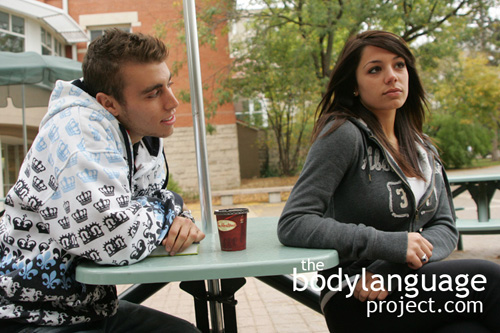Body Language Meaning of Arm Cross With Clenched Fists
 Cue: Arm Cross With Clenched Fists.
Cue: Arm Cross With Clenched Fists.
Synonym(s): Clenched Fist Arm Cross.
Description: The arms fold over the chest coupled with balled up fists.
In One Sentence: Balled fists display desire for power and when coupled with arms crossed shows that one is steadfast in disagreement.
How To Use it: Use the arm cross with balled fists to show restrained anger. This is useful in a confrontation when words are not permitted to display a high level of frustration and anger. Couple the posture with an angry facial expression to show others that you should be taken seriously and that you are working hard to contain your deeply felt aggression. The posture is useful in situations where you wish to show that aggression is immanent and that people should back off and give you some space and time to relax.
Context: General.
Verbal Translation: “I’m shielding myself from outside negative stimuli by crossing my arms. My fists are balled due to anger and aggression.”
Variant: See Arm Crossing, Arms Crossed With Gripped Arm or Reinforced Arm Cross, Arms Crossed With Thumbs Up.
Cue In Action: Upon hearing bad news, Mary folder her arms across her chest, but when she found out there was an accident she gripped her arms tightly. The more she listened, the more obvious it was that the culprit had done it on purpose. She released her arms and instead balled up her fists.
Meaning and/or Motivation: Arms crossed with clenched fist shows defensiveness or even hostility nearing anger or aggression. It is a sign of authority and control that is commonly seen in police officers.
The meaning and motivation of arm crossing is varied, complex and universal (see variants).
Arms, as they relate to non-verbal meaning, are like shields. They can block and shank ideas from entering just as well as a shield can protect against swords and arrows. Using the arms across the body in a fold is like cutting off access to our core where our heart and lungs are present. The arm crossing usually shows defensiveness and protectiveness, but can also show aggression and anger depending on its variant. Arm crossing simultaneously holds our feelings inside and prevents other people’s feelings from entering. Alternatively, arms crossed indicate that a person is cold. To determine if someone is cold just watch for hands tucked under the armpits, shivering, with legs tightly pressed together.
Cue Cluster: Arm crossing is usually coupled with head up, down or turned away, shoulders oriented away or toward, legs crossed and various negative facial expressions. When arm crossing is combined with a tight-lipped smile or clenched teeth it signifies that a verbal or physical confrontation is immanent.
Body Language Category: Defensive, Hostility, Anger, Closed, Dislike (nonverbal), Indicators of disinterest (IOD), Protective reflexes, Stubborn or stubbornness, Body cross, Clenching and gripping.
Resources:
Aguinis, Herman ; Simonsen, Melissam. ; Pierce, Charlesa. Effects of Nonverbal Behavior on Perceptions of Power Bases. The Journal of Social Psychology. 1998. 138(4): 455-469.
Berkowitz, L., & Harmon-Jones, E. (2004). Toward an understanding of the determinants of anger. Emotion, 4, 107-130.
Baxter, James C., and Richard M. Rozelle (1975). “Nonverbal Expression as a Function of Crowding During a Simulated Police-Citizen Encounter.” In Journal of Personality and Social Psychology (Vol. 32, No. 1), pp. 40-54.
Craig, A. D. (2002). How do you feel? Interoception: The sense of the physiological condition of the body. Nature Reviews Neuroscience, 3, 655-666.
Cacioppo, J. T., Priester, J. R., & Berntson, G. G. (1993). Rudimentary determinants of attitudes: II. Arm flexion and extension have differential effects on attitudes. Journal of Personality and Social Psychology, 65, 5–17.
Doody, John ; Bull, Peter. Asperger’s Syndrome and the Decoding of Boredom, Interest, and Disagreement from Body Posture. Journal of Nonverbal Behavior. 2011. 35(2): 87-100.
Da Gloria, Jorge ; Duda, Danièle ; Pahlavan, Farzaneh ; Bonnet, Philippe. “Weapons effect” revisited: Motor effects of the reception of aversive stimulation and exposure to pictures of firearms. Aggressive Behavior. 1989 15(4): 265-271.
DeSteno, D.; Breazeal, C.; Frank, R. H.; Pizarro, D.; Baumann, J.; Dickens, L, and Lee, J. Detecting the Trustworthiness of Novel Partners in Economic Exchange. Psychological Science. 2012. 23, 1549-1556.
http://bodylanguageproject.com/articles/use-body-language-cues-create-trust
Enquist, M. (1985). Communication during aggressive interactions with particular
reference to variation in choice of behaviors. Anim. Behav. 33, 1152-1161.
Fo¨rster, J. (2004). How body feedback influences consumer’s evaluation of products. Journal of Consumer Psychology, 14, 415–425.
Friedman, R. S., & Fo¨rster, J. (2000). The effects of approach and avoidance motor actions on the elements of creative insight. Journal of Personality and Social Psychology, 79, 477–492.
Friedman, Ron and Andrew J. Elliot. The Effect Of Arm Crossing On Persistence And Performance. European Journal of Social Psychology. 2008; 38, 449–461 (2008). http://bodylanguageproject.com/articles/arm-crossing-effect-on-persistence-and-performance/
Gregersen, Tammy S. Nonverbal Cues: Clues to the Detection of Foreign Language Anxiety. Foreign Language Annals. 2005. 38(3): 388-400
http://bodylanguageproject.com/articles/what-anxious-learners-can-tell-us-about-anxious-body-language-how-to-read-nonverbal-behavior/
Gorkan Ahmetoglu, Viren Swami. Do Women Prefer “Nice Guys?” The Effect Of Male Dominance Behavior On Women’s Ratings. Social Behavior And Personality, 2012; 40(4), 667-672.
http://bodylanguageproject.com/articles/how-to-significantly-increase-male-attractiveness-with-simple-body-language-nice-guys-finish-last-once-again/
Hall, Jeffrey A. and Chong Xing. The Verbal and Nonverbal Correlates of the Five Flirting Styles. Journal of Nonverbal Behavior. 2015. 39:41–68. DOI 10.1007/s10919-014-0199-8
http://bodylanguageproject.com/articles/first-12-minutes-flirting-using-nonverbal-communication-study-reveals-26-body-language-cues-attraction/
Hung, Iris W. and Aparna A. Labroo. From Firm Muscles to Firm Willpower: Understanding the Role of Embodied Cognition in Self-Regulation. Journal of Consumer Research. 2011 37(6): 1046-1064.
http://bodylanguageproject.com/articles/firm-muscles-lead-willpower/
Hohmann, G. and Fruth, B. (2003). Intra- and intersexual aggression by bonobos in
the context of mating. Behavior 140, 1389-1413.
Johnson, Richard R. and Jasmine L. Aaron. Adults’ Beliefs Regarding Nonverbal Cues Predictive of Violence. Criminal Justice and Behavior. 2013. 40 (8): 881-894. DOI: 10.1177/0093854813475347.
http://bodylanguageproject.com/articles/wanna-fight-nonverbal-cues-believed-indicate-violence/?preview=true
Laird, J. D., Wagener, J. J., Halal, M., & Szegda, M. (1982). Remembering what you feel: Effects of emotion on memory. Journal of Personality and Social Psychology, 42, 646–657.
Lee Ann Renninger, T. Joel Wade, Karl Grammer. Getting that female glance: Patterns and consequences of male nonverbal behavior in courtship contexts. Evolution and Human Behavior. 2004; 25: 416–431.
http://bodylanguageproject.com/articles/part-i-how-to-read-male-sexual-body-language-a-study-for-women-and-the-men-who-wish-to-cheat-the-system/
Morgan, M. H. and Carrier, D. R. (2013). Protective buttressing of the human fist and the evolution of hominin hands. J. Exp. Biol. 216, 236-244.
Marsh, Abigail A; Henry H. Yu; Julia C. Schechter and R. J. R. Blair. Larger than Life: Humans’ Nonverbal Status Cues Alter Perceived Size. PLoS ONE. 2009. 4(5): e5707. doi:10.1371/journal.pone.0005707.
http://bodylanguageproject.com/articles/large-life-nonverbal-dominance-affects-perception-size/?preview=true
Morris, Desmond (1994). Bodytalk: The Meaning of Human Gestures (New York: Crown Publishers).
Nickle, David C. and Leda M. Goncharoff. Human Fist Evolution: A Critique. J Exp Biology. 2013. 216: 2359-2360. doi: 10.1242/jeb.084871.
Navarro, Joe. 2008. What Every BODY is Saying: An Ex-FBI Agent’s Guide to Speed-Reading People. William Morrow Paperbacks.
Pease, Barbara and Allan Pease. 2006. The Definitive Book of Body Language Hardcover. Bantam.
Neumann, R., & Strack, F. (2000). Approach and avoidance: The influence of proprioceptive and exteroceptive cues on encoding of affective information. Journal of Personality and Social Psychology, 79, 39–48.
Parker, G. A. (1974). Assessment strategy and the evolution of fighting behaviour. J.
Theor. Biol. 47, 223-243.
Rule, Nicholas, O.; Reginald B. Adams Jr.; Nalini Ambady and Jonathan B. Freeman. Perceptions Of Dominance Following Glimpses Of Faces And Bodies. Perception. 2012; 41: 687-706 doi:10.1068/p7023
http://bodylanguageproject.com/articles/people-can-read-dominance-split-second
Rizzolatti, G., Fadiga, L., Matelli, M., Bettinardi, V., Paulesu, E., Perani, D., & Fazio, F. (1996). Localization of cortical areas responsive to the observation of grasp presentations in humans by PET: 1. Observation versus execution. Experimental Brain Research, 111, 246-252.
Riskind, J. H., & Gotay, C. C. (1982). Physical posture: Could it have regulatory or feedback effects upon motivation and emotion? Motivation and Emotion, 6, 273–296.
Richmond, Virginia P., James C. McCroskey and Steven K. Payne (1991). Nonverbal Behavior in Interpersonal Relations (2nd Ed., Englewood Cliffs, New Jersey: Prentice Hall).
Smith-hanen, Sandra S. Osipow, Samuel H. (editor). Effects of nonverbal behaviors on judged levels of counselor warmth and empathy. Journal of Counseling Psychology. 1977. 24(2): 87-91.
Stepper, S., & Strack, F. (1993). Proprioceptive determinants of emotional and nonemotional feelings. Journal of Personality and Social Psychology, 64, 211–220.
Schubert, Thomas W. and Koole, Sander L. The embodied self: Effects of making a fist on the implicit and explicit self-concept of men and women. Journal of Experimental Social Psychology. 2009. 45: 828-834.
Schiff, B. B., & Lamon, M. (1994). Inducing emotion by unilateral contraction of hand muscles. Cortex, 30, 247-254.
Szalai, F. and Szamado, S. (2009). Honest and cheating strategies in a simple model
of aggressive communication. Anim. Behav. 78, 949-959.
Szamado, S. (2008). How threat displays work: species-specific fighting techniques,
weaponry and proximity risk. Anim. Behav. 76, 1455-1463.
Schubert, Thomas W. The Power In Your Hand: Gender Differences In Bodily Feedback
From Making a Fist. Society for Personality and Social Psychology. 2004. 30(6): 757-769. DOI: 10.1177/0146167204263780
http://bodylanguageproject.com/articles/men-view-power-body-language-different-women-bodily-feedback-making-fist/
Tops, Mattie ; Jong, Ritske. Posing for success: Clenching a fist facilitates approach
Psychonomic Bulletin & Review. 2006, Vol.13(2): 229-234
Teixeira Fiquer, Juliana; Paulo Sérgio Boggio and Clarice Gorenstein. Talking Bodies: Nonverbal Behavior in the Assessment of Depression Severity. Journal of Affective Disorders. 2013. 150: 1114-1119.
http://bodylanguageproject.com/articles/using-nonverbal-behaviour-to-assess-depression-severity/
Tiziano Furlanetto; Alberto Gallace; Caterina Ansuini and Cristina Becchio. Effects of Arm Crossing on Spatial Perspective-Taking. PLoS ONE 9(4): e95748. 2014. DOI: 10.1371/journal.pone.0095748
http://bodylanguageproject.com/articles/arm-crossing-makes-difficult-take-perspective/
Tamir, M., Robinson, M. D., Clore, G. L., Martin, L. L., & Whitaker, D. J. (2004). Are we puppets on a string? The contextual meaning of unconscious expressive cues. Personality and Social Psychology Bulletin, 30, 237–249.
Vrugt, Anneke, and Ada Kerkstra (1984). “Sex Differences in Nonverbal Communication.” In Semiotica (50-1/2), pp. 1-41.
Young, R. W. (2003). Evolution of the human hand: the role of throwing and clubbing.
J. Anat. 202, 165-174.





